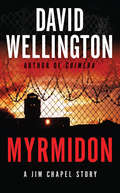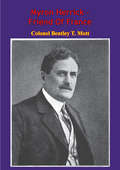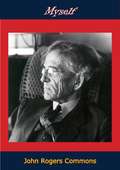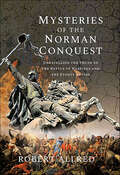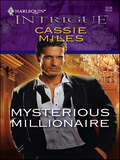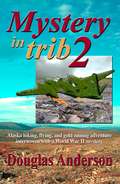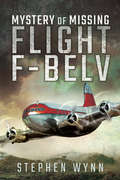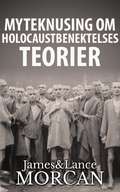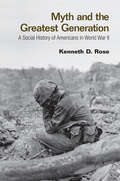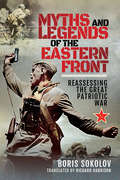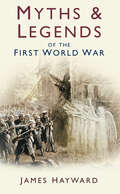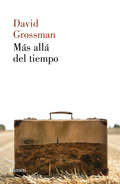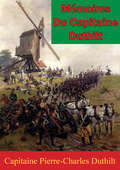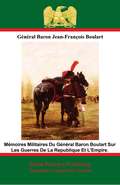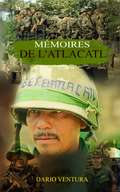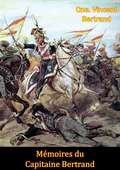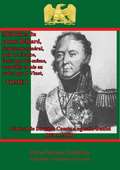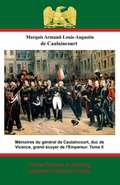- Table View
- List View
Myrmidon
by David WellingtonAn e-book original action thriller by acclaimed author David Wellington. Wounded Special Forces veteran Jim Chapel now specializes in missions improbable (and sometimes impossible). After confronting a Russian triple agent, Chapel must infiltrate a separatist militia group to track and seize contraband Russian weaponry. But the militia leader has his own agenda . . . and an ace up his sleeve.
Myron Herrick - Friend Of France
by Colonel T. Bentley MottThe Biography of the foremost Francophile diplomat, possessed of political courage a sharp wit and a winning charm."Herrick was born in Huntington, Lorain County, Ohio, the son of Timothy Robinson Herrick a local farmer. He studied at Oberlin College and Ohio Wesleyan University, but graduated from neither. He married Carolyn M. Parmely of Dayton, Ohio on June 30, 1880. They had one son, Parmely Webb Herrick.From 1885 to 1888, Herrick was a member of Cleveland City Council.[1][2] In 1886, he helped to finance the founding of The National Carbon Company, along with W. H. Lawrence, James Parmelee, and James Webb Cook Hayes (see Webb Hayes), son of U.S. President Rutherford B. Hayes, in Cleveland, Ohio. This company would come to figure prominently in the history of the consumer battery and the flashlight.Herrick was a Presidential elector in 1892 for Harrison/Reid.Herrick served as the Governor of Ohio from 1904 to 1906; (future United States President) Warren G. Harding served as his Lieutenant Governor. He had been a protégé of political boss Mark Hanna, but in 1906 was defeated by the efforts of Wayne Wheeler and the Anti-Saloon League after he refused to support their plan for prohibition of alcohol in Ohio.He subsequently served as United States Ambassador to France from 1912 to 1914 and again from 1921 to 1929. He is the only American ambassador to France with a street named after him in Paris, in the 8th arrondissement. Herrick was the ambassador who hosted Charles Lindbergh in Paris after his successful New York to Paris Atlantic crossing in 1927.[5] He was an unsuccessful candidate for the U.S. Senate in 1916 against Atlee Pomerene.Herrick was serving as United States Ambassador to France at the time of his death on March 31, 1929. He died from a heart attack. He is interred at Lake View Cemetery in Cleveland, Ohio."-Wiki
Myself
by John Rogers CommonsJohn R. Commons (1862-1945) was one of the most significant figures in the development of American economics, both owing to his economic thought and his impact on practical affairs. He began as an avid follower of the Social Gospel, committed to a program of economic and political reform, and later in his career he became the foremost authority on American labor unions. One of the founders of the Institutional school, Commons developed theories of the evolution of capitalism and of institutional change which continue to influence modern economics.The present volume, which was first published in 1934, is his autobiography. In it, Commons classifies himself as both a pragmatist and a Progressive. He collaborated closely with Wisconsin’s governor and U.S. senator Robert La Follette, Sr., until 1917, when he opposed La Follette’s anti-war position. He drafted innovative legislation on issues such as civil service reform, worker’s compensation, and utility regulation. He championed improved safety standards and unemployment benefits for workers, believing that financial support for them should come from corporations. He also advocated government mediation among industry, labor, and other competing interest groups. In the 1920s, Commons’ legislative initiatives on social welfare and federal economic coordination anticipated New Deal legislation. Commons also exerted long- term influence through his students, many of whom went on to occupy key academic, research, and policy positions. Today, he is remembered chiefly as the founder of modern American labor history.
Mysteries of the Norman Conquest: Unravelling the Truth of the Battle of Hastings and the Events of 1066
by Robert AllredRecent challenges to the traditional site of the Battle of Hastings have led to a surge of interest in the events surrounding England’s most famous battle. This, in turn, has increased speculation that the titanic struggle for the English crown in 1066 did not take place on the slopes of what is today Battle Abbey, with a number of highly plausible alternative locations being proposed. The time had clearly come to evaluate all these suggestions, and Robert Allred decided to take on that task. Taking nothing for granted, Robert hiked round the sites of the three battles of 1066 – Fulford, Stamford Bridge and Hastings. Armed with the medieval sources and much of the current literature, he set out to appraise the evidence and to draw his own unbiased conclusions. Following in the footsteps of the Viking warriors of Harald Hardrada, the knights of William of Normandy and the Anglo-Saxon soldiers of King Harold, the reader is taken on a journey from Yorkshire to the South Coast and down through the ages to re-examine what has been written about that momentous year – the intrigues, preparations and manoeuvres – which culminated on 14 October 1066, on a bloody hill somewhere in Sussex. Whether this will settle the debate over the site of the Battle of Hastings or prompt further investigations remains to be seen, but it will be a book which cannot be ignored and which the reader will be unable to put down!
Mysterious Millionaire
by Cassie MilesLiz Norton's part-time P.I. gigs were run-of-the-millcustody disputes—until she went undercover on thewealthy Crawford estate. Posing as an unobtrusivehousekeeper in what was supposed to be a routine case,she soon found herself in serious danger. But with a deadbody on her hands and feuding relatives pointing fingers,the only one she could turn to was Ben Crawford—anenigmatic, single father fighting to keep his young daughter.Except joining forces with the ruggedly handsomebusinessman only made her yearn to drop the charade,which could prove fatal, with a killer prowling the darkestcorners of the mansion.…
Mystery in Trib 2: Alaska hiking, flying, and gold mining adventure interwoven with a World War II mystery
by Douglas AndersonAs a sequel to Gold in Trib 1, Doug's new book, Mystery in Trib 2 is an interesting blend of fact and fiction; factual in terms of the flying, hiking, and gold-mining two friends enjoyed; fictional in the form of a cleverly woven mystery concerning the loss of a World War II military aircraft. The story is well researched and so masterfully formulated the reader will be hard pressed to separate historical fact from fiction. Mystery in Trib 2 portrays wilderness Alaska accurately and as it can be experienced by anyone fired with a lust for outdoor adventure.
Mystery of Missing Flight F-BELV
by Stephen WynnThe true story of the aircraft that disappeared between Saigon and Hanoi, one of the enduring mysteries of the Vietnam War.Following the Geneva Accords in 1954, Vietnam found itself separated into North and South, with communist North Vietnam under the control of Ho Chi Minh. At the same time, the International Commission for Supervision and Control (ICSC) was established, whose role it was to oversee the implementation of the Accords.On October 18, 1965, an ICSC aircraft, F-BELV, was on a regular weekly flight from Saigon to Hanoi, stopping at Phnom Penh, in Cambodia, and Vientiane, in Laos. Twenty minutes after leaving Vientiane, the captain contacted the authorities at Hanoi to give his ETA, but the aircraft never arrived. It is believed to be the only aircraft never to have been recovered from the Vietnam War.But what really happened and why? Did the aircraft crash, or was it shot down? Did it happen over Laos or North Vietnam?Mystery of Missing Flight F-BELV examines all aspects of the Vietnam War, particularly the events of 1965, and how tensions in the region heightened as the first American combat troops arrived in Vietnam. It investigates the role of the CIA, and whether their involvement had any bearing on the disappearance of F-BELV. It looks at those on board the aircraft, including James Sylvester Byrne, a sergeant in the Canadian Army and a relation to the author of this book. Was he just a regular soldier? Or was he really an intelligence officer gathering information to share with the Americans? This compelling book delves into these questions and into one of the enduring mysteries of the war.
Mystery on the Mountain: The Drama of the Sinai Revelation
by Theodor ReikAn illustrated collection of twelve comparative folk tales, ten African and two Jewish."A great psychoanalyst," notes the front jacket panel, "intimate friend and colleague of Sigmund Freud—sheds new light on the origins and meaning of Judaeo-Christian religion.A choice anecdote about Anatole France, published not long after his death in memoirs by an intimate friend, seems easily the best way to introduce the story of the long journey I have undergone in preparing the present book. The anecdote presents the renowned author in an amiable conversation with the secretary of a magazine, who asks impatiently why it is necessary for so seasoned a writer to delay so long before correcting galley proofs. The author explains: “I have first to forget what I have written in order to see it with new eyes. Only then do I become aware of what is not immediately understandable and of what is not simple and clear.” He adds finally: “You see, what is natural comes only at the end.”
Myteknusing om Holocaustbenektelses Teorier
by James Morcan Lance Morcan Elisabet NorrisMyteknusing om Holocaustbenektelses Teorier: To Ikke-Jøder Bekrefter Nazistenes Folkemord Historisitet, er skrevet av de to uavhengige undersøkerne og filmskaperne, James Morcan & Lance Morcan med forord skrevet av Holocaust overlevende, Hetty E. Verolme (forfatter av The Children's House of Belsen). Hensikten med denne boken er å gjøre ende på benektelsen en gang for alle, ved å gå rett på sak med å takle dette bisarre fenomen. Skrevet i nært samsvar med Holocaust overlevende og andre verdenskrigs historikere, snur de hver stein ved å verifisere, nøyaktig, de historiske sannhetene om folkemordet. Morcan teamet presenterer en lang rekke resurrser som inkluderer nazi dokumenter, øyenvitneskildringer, vitenskaplige rapporter og sjokkerende fotografiske bevis, som slår ned debatten som benekterne så flittig forsøker å få til. De forskjellige argumentene som Holocaust benekterne bruker for å nedvurdere krigstids dokumenter, er nøye undersøkt og systematisk feilbevist. Myteknuste teorier inkluderer: At de seks millioner dødsfall tallene er en overdrivelse; utryddelser i gasskamre er oppdiktet; Adolf Hitler og det tredje rike er feil ærekrenket; analyse av Holocaust dokumenter er en tabu, fordi enkelte lover i Europa kriminaliserer benekterne, «onde sionister» og Israel er så mektige at de kan sensurere historie. Holocaust har vist seg, i denne bokens sider, til å være en av de mest veldokumenterte og mest historisk og vitenskapelig beviste forbrytelser i det 20. århundre. I prosessen, er mange av verdens mest ill beryktede benektere avslørt til å være ikke noe mer enn antisemitter som søker å ærekrenke, undervurdere, og forderve verdens jødiske menneskeheten. Disse inkluderer den vanærede britiske historikeren, David Irving og den tidligere iranske presidenten, Mahmoud Ahmadinejad. Denne boka klargjør også over to årtusener og en global historie, hvor antisemittisme, helt fra bibelens tid, ha
Myth and Reality: Studies on the Templars and Hospitallers, Medieval Narratives, and the Trial of the Templars (Variorum Collected Studies)
by Helen J. NicholsonSpanning thirty-five years of scholarly research, the articles in this collection represent key research findings from Helen J. Nicholson’s studies of the military religious orders and the crusades. Ranging across subjects as diverse as the Templars’ religious practices, Arthurian romance inspired by the events of the Third Crusade, medieval European Christians’ views of Muslims, and a heresy investigation in Ireland, these articles reflect Nicholson’s research into the Templars and Hospitallers as religious institutions, medieval European fictional literature as an historical source, and the trial of the Templars.Aimed at university students, scholars, and enthusiasts on the military orders, this volume makes this research available again to a new generation of readers.
Myth and the Greatest Generation: A Social History of Americans in World War II
by Kenneth RoseMyth and the Greatest Generation calls into question the glowing paradigm of the World War II generation set up by such books as The Greatest Generation by Tom Brokaw. Including analysis of news reports, memoirs, novels, films and other cultural artefacts Ken Rose shows the war was much more disruptive to the lives of Americans in the military and on the home front during World War II than is generally acknowledged. Issues of racial, labor unrest, juvenile delinquency, and marital infidelity were rampant, and the black market flourished. This book delves into both personal and national issues, calling into questions the dominant view of World War II as ‘The Good War’.
Myths and Legends of the Eastern Front: Reassessing the Great Patriotic War
by Boris Sokolov“This English translation of the original Russian work is thought provoking, challenging the ‘official’ version of what happened” during World War II (Firetrench).The memory of the Second World War on the Eastern Front—still referred to in modern Russia as the Great Patriotic War—is an essential element of Russian identity and history, as alive today as it was in Stalin’s time. It is represented as a defining episode, a positive historical myth that sustains the Russian national idea and unites the majority of Russian citizens.As a result, as Boris Sokolov shows in this powerful and thought-provoking study, the heroic and tragic side of the war is highlighted while the dark side—the incompetent, negligent and even criminal way the war was run—is overlooked. Although almost eighty years have passed since the defeat of Nazi Germany, he demonstrates that many of the fabrications put forward during the war and immediately afterwards persist into the present day.In a sequence of incisive chapters he uncovers the truth about famous wartime episodes that have been consistently misrepresented. His bold reinterpretation should go some way towards dispelling the enduring myths about the Great Patriotic War. It is necessary reading for anyone who is keen to understand how it continues to be distorted in Russia today.
Myths and Legends of the Eastern Front: Reassessing the Great Patriotic War
by Boris Sokolov“This English translation of the original Russian work is thought provoking, challenging the ‘official’ version of what happened” during World War II (Firetrench).The memory of the Second World War on the Eastern Front—still referred to in modern Russia as the Great Patriotic War—is an essential element of Russian identity and history, as alive today as it was in Stalin’s time. It is represented as a defining episode, a positive historical myth that sustains the Russian national idea and unites the majority of Russian citizens.As a result, as Boris Sokolov shows in this powerful and thought-provoking study, the heroic and tragic side of the war is highlighted while the dark side—the incompetent, negligent and even criminal way the war was run—is overlooked. Although almost eighty years have passed since the defeat of Nazi Germany, he demonstrates that many of the fabrications put forward during the war and immediately afterwards persist into the present day.In a sequence of incisive chapters he uncovers the truth about famous wartime episodes that have been consistently misrepresented. His bold reinterpretation should go some way towards dispelling the enduring myths about the Great Patriotic War. It is necessary reading for anyone who is keen to understand how it continues to be distorted in Russia today.
Myths and Legends of the First World War
by James HaywardDuring the First World War, a rich crop of legends sprouted from the battlefields and grew with such ferocity that many still excite controversy today. This book is the first to examine the roots of those stories and reveal the truth. Some myths remain well-known. Did an entire battalion of the Norfolk Regiment vanish without trace at Gallipoli in 1915? Did thousands of Russian troops actually pass through England with snow on their boots? In 1914, an acute spy mania gripped the British public, who imagined that the country was brimming with German spies. Xenophobia, denunciations and attacks on dachshunds were rampant. Amazingly, there was even talk of enemy aircraft dropping poisoned sweets to kill British children. Myths such as the Angel of Mons and the Comrade in White were more innocent creations. With no radio or television, rumours of disaster were rife, and the apparition of mystical guardian spirits gave hope to the civilian population at home. Other stories, such as the so-called Crucified Canadian, and the existence of a gruesome German corpse rendering factory, were more sinister. Yet in an age of new and startling technologies such as poison gas, submarine warfare and the tank, such tales appeared believable. Using a wide range of contemporary sources, James Hayward traces the story of each myth and examines the likely explanation. Supported by a selection of rare photographs and illustrations, the result is a refreshingly different perspective on the common ‘mud and trenches’ view of the First World War, shedding fascinating new light on many curious and unexplained wartime tales.
Más allá del tiempo
by David GrossmanUsando las palabras como anclas para no caer en la locura, David Grossman, Man Booker International Prize 2017, ha querido cerrar una historia que empezó con La vida entera y nos lleva a lugares donde solo el genio de un gran escritor puede llegar. Calladosestuvimos esperando la mañana.Una mañanaque nollegaba.La sangrenocorría por las venas.Me levanté, te envolvíen una manta,me agarraste la mano, me mirastea los ojos: el hombrey la mujerque un día fuimosinclinaron la cabezaen señal de despedida. Esa fue la mañana en que un hombre y una mujer perdieron a su hijo. Ahora, cinco años después, él emprende una marcha desesperada más allá del tiempo para encontrarse con este joven que ya no habla, ya no sonríe... ya no es. En el camino le acompañan otros peregrinos, todos buscando a sus hijos, y en ese peregrinaje aprenden a desafiar a lamuerte y a morder el dolor.
Mémoires Du Capitaine Duthilt
by Général de Division Camille Baruch Lévi Capitaine Pierre-Charles Duthilt« Ces souvenirs, bien que rédigés tardivement et souhaitant être avant tout l'histoire du régiment, contiennent d'intéressants détails sur l'armée de Naples et la campagne des Calabres (ch. X-XI). Après avoir surtout combattu en Italie, Duthilt a participé à la bataille de Waterloo dont il donne un vivant récit (ch. XVIII). Il a un sens aigu de la description (cf. ses excursions à Naples, pp. 220-224, ou à Vérone, pp. 257-259) et indique avec précision ses étapes. Il reproduit des chansons et des hymnes maçonniques (p. 266) » p 56-57 - Professeur Jean Tulard, Bibliographie Critique Sur Des Mémoires Sur Le Consulat Et L'Empire, Droz, Genève, 1971
Mémoires Du Général Bigarré, Aide De Camp Du Roi Joseph
by Général Baron Auguste BigarréMémoires du général Bigarré, aide de camp du roi Joseph. Paris, Kolb, 1893, in-80, XV-320 p.« Ces souvenirs ont été écrits en 1830. Entré à la garde consulaire, Bigarré assiste au sacre puis à la bataille d'Austerlitz. Son régiment ayant perdu un drapeau à Austerlitz, il se cabre sous les reproches de Napoléon (pp. 180-183) et passe aide de camp de Joseph qu'il suit à Madrid (chapitres IX-XI), le récit s'arrête en 1812. Racontées naïvement les conquêtes galantes et les infortunes conjugales de Bigarré donnent à ses souvenirs un ton plaisant. Malheureusement, l'appareil critique fait défaut. » p 18 - Professeur Jean Tulard, Bibliographie Critique Des Mémoires Sur Le Consulat Et L'Empire, Droz, Genève, 1971.
Mémoires Militaires De Joseph Grabowski: Officier À L’État-Major Impérial De Napoléon Ier 1812-1813-1814
by Józef Ignacy Tadeusz Grabowski« Souvenirs d'un Polonais gagné par les idées françaises et qui s'engagea dans le 5° corps commandé par Poniatowski. Ce n'est qu'à la fin de la campagne de 1812 qu'il fut appelé comme officier d'ordonnance auprès de Napoléon. Il a participé à la bataille de Leipzig (récit de la disparition de Poniatowski) et à la campagne de France. Il éclaire le rôle des bulletins (p. 45) et relève les erreurs de Thiers (p. 97). Ses mémoires s'achèvent en 1814. Chuquet les juge très utiles (Episodes et souvenirs, 2° série, pp. 168-199). » p 76 - Professeur Jean Tulard, Bibliographie Critique Sur Des Mémoires Sur Le Consulat Et L'Empire, Droz, Genève, 1971
Mémoires Militaires Du Général Baron Boulart Sur Les Guerres De La Republique Et La Empire.
by Général Baron Jean-François Boulart« L'Italie en 1800, le sacre, le siège Dantzig, le bataille de Friedland, le guerre d'Espagne, La campagne de Allemagne en 1809, La Russie, la chute de l'Empire constituent les principaux épisodes de ces utiles mémoires, dans l'ensemble assez exacts. » p 23 - Professeur Jean Tulard, Bibliographie Critique Sur Des Mémoires Sur Le Consulat Et L'Empire, Droz, Genève, 1971
Mémoires de l´Atlacatl: De la guerre à la Paix
by Dario VenturaL'auteur a étudié les Sciences de la Communication à l'Université Doctor Andrés Bello. Il a été professeur de Lettres Enseignant les matières de Cinématographie, Télévision, Relations Publiques. Il a été juge du processus de graduation et assesseur de thèse en Sciences de la Communication. Il a particpé à divers festivals de cinéma. En 2010 il a produit le documentaire Pan et Revolver qui fut la sélection nationale du festival Icaro. Il écrit des Récits d'Investagations historiques. De plus, il a fait des incursions dans l'écriture de Fiction. Il écrit aussi sur la motivation et le dépassement de soi pour inciter les jeunes à se proposer de grands idéaux. Il est passionné par l'écriture de la philosophie moraliste sur laquelle il écrit sur .
Mémoires du Capitaine Bertrand
by Cne. Vincent Bertrand« La campagne de 1805, Iéna, Eylau, Tilsit, Wagram, la Russie, 1813 et 1815 (en Alsace) sont évoqués dans ces vivants mémoires. » p. 17 Professeur Jean Tulard, Bibliographie Critique Des Mémoires Sur Le Consulat Et L’Empire, Droz, Genève, 1971
Mémoires du comte Belliard, lieutenant-général, pair de France écrits par lui-même (Mémoires du comte Belliard, lieutenant-général #1)
by Général de Division Comte Augustin-Daniel Belliard« Mémoires du comte Belliard, lieutenant-général, pair de France écrits par lui-même, recueillis et mis en ordre par M. Vinet, l'un de ses aides-de-camp. Paris, Berguet et Petion, 1842, 3 vol. in-8°.Publication décousue où des lettres de Murat à Belliard en 1812 suivent le récit de la bataille de Valmy. Les affaires d'Espagne, une conversation avec l'Empereur à Dresde, des lettres de Napoléon à Murat du 25 août au 13 octobre 1813, un récit de la capitulation de Paris, une lettre du capitaine Magnien sur la défection de Souham, l'entrevue à Fontainebleau en 1814 avec un illuminé qui veut annoncer à l'Empereur qu'il régnera encore mais que des malheures plus grand suivront, etc. en forment l'essential. » p 15/16 - Professeur Jean Tulard, Bibliographie Critique Des Mémoires Sur Le Consulat Et L'Empire, Droz, Genève, 1971TOME I seul.
Mémoires du général de Caulaincourt, duc de Vicence, grand écuyer de l’Empereur. Tome I (Mémoires du général de Caulaincourt, duc de Vicence, grand écuyer de l’Empereur. #1)
by Jean Hanoteau Général de Division Armand Augustin Louis de Caulaincourt, Duc de Vincence« Caulaincourt n'avait cessé sous l'Empire de prendre des notes chaque jour au bivouac ou dans le cabinet de Tuileries. Il se serait décidé à les mettre en forme entre 1822 et 1825. L'énorme documentation réunie quotiennement explique la valeur du témoignage du duc de Vicenze... le récit ne commence qu'à l'entrevue d'Erfurt. Il se poursuit avec la campagne de Russie et la retraite. C'est dans les chapitres VII-VIII et XI ( « En traîneau avec l'Empereur » ) souvent réédites que l'on dispose d'un document de premier ordre sur l'état d'esprit de Napoléon après le désastre de 1812. Quittant la Grande Armée, l'Empereur voyage en la seule compagnie de Caulaincourt de Smorgoni à Paris. Pendant ce long voyage, Napoléon se confie au Grand Ecuyer avec d'autant plus de franchise qu'il ignore que Caulaincourt prend des notes. « Puis Caulaincourt narre les péripéties de Congrès de Châtillon et y justifie son attitude. On notera d'importants développements sur l'entrée des Alliés à Paris, l'attitude de Napoléon, la défection de Marmont, l'abdication et la tentative de suicide de l'Empereur. Les mémoires s'arrêtent aux « Adieux de Fontainebleau » p 33 - Professeur Jean Tulard, Bibliographie Critique Sur Des Mémoires Sur Le Consulat Et L'Empire, Droz, Genève, 1971
Mémoires du général de Caulaincourt, duc de Vicence, grand écuyer de l’Empereur. Tome II (Mémoires du général de Caulaincourt, duc de Vicence, grand écuyer de l’Empereur. #2)
by Général de Division Armand Augustin Louis de Caulaincourt, Duc de Vincence« Caulaincourt n'avait cessé sous l'Empire de prendre des notes chaque jour au bivouac ou dans le cabinet de Tuileries. Il se serait décidé à les mettre en forme entre 1822 et 1825. L'énorme documentation réunie quotiennement explique la valeur du témoignage du duc de Vicence... le récit ne commence qu'à l'entrevue d'Erfurt. Il se poursuit avec la campagne de Russie et la retraite. C'est dans les chapitres VII-VIII et XI [ « En traîneau avec l'Empereur » ] souvent réédites que l'on dispose d'un document de premier ordre sur l'état d'esprit de Napoléon après le désastre de 1812. Quittant la Grande Armée, l'Empereur voyage en la seule compagnie de Caulaincourt de Smorgoni à Paris. Pendant ce long voyage, Napoléon se confie au Grand Ecuyer avec d'autant plus de franchise qu'il ignore que Caulaincourt prend des notes.« Puis Caulaincourt narre les péripéties de Congrès de Châtillon et y justifie son attitude. On notera d'importants développements sur l'entrée des Alliés à Paris, l'attitude de Napoléon, la défection de Marmont, l'abdication et la tentative de suicide de l'Empereur. Les mémoires s'arrêtent aux « Adieux de Fontainebleau » p 33 - Professeur Jean Tulard, Bibliographie Critique Des Mémoires Sur Le Consulat Et L'Empire, Droz, Genève, 1971Tome II - Moscou, La Retraite, En Traîneau Avec l'Empereur, L'Arrivée à Paris
Mémoires du général de Caulaincourt, duc de Vicence, grand écuyer de l’Empereur. Tome III (Mémoires du général de Caulaincourt, duc de Vicence, grand écuyer de l’Empereur. #3)
by Général de Division Armand Augustin Louis de Caulaincourt, Duc de Vincence« Caulaincourt n'avait cessé sous l'Empire de prendre des notes chaque jour au bivouac ou dans le cabinet de Tuileries. Il se serait décidé à les mettre en forme entre 1822 et 1825. L'énorme documentation réunie quotiennement explique la valeur du témoignage du duc de Vicence... le récit ne commence qu'à l'entrevue d'Erfurt. Il se poursuit avec la campagne de Russie et la retraite. C'est dans les chapitres VII-VIII et XI [ « En traîneau avec l'Empereur » ] souvent réédites que l'on dispose d'un document de premier ordre sur l'état d'esprit de Napoléon après le désastre de 1812. Quittant la Grande Armée, l'Empereur voyage en la seule compagnie de Caulaincourt de Smorgoni à Paris. Pendant ce long voyage, Napoléon se confie au Grand Ecuyer avec d'autant plus de franchise qu'il ignore que Caulaincourt prend des notes.« Puis Caulaincourt narre les péripéties de Congrès de Châtillon et y justifie son attitude. On notera d'importants développements sur l'entrée des Alliés à Paris, l'attitude de Napoléon, la défection de Marmont, l'abdication et la tentative de suicide de l'Empereur. Les mémoires s'arrêtent aux « Adieux de Fontainebleau » p 33 - Professeur Jean Tulard, Bibliographie Critique Des Mémoires Sur Le Consulat Et L'Empire, Droz, Genève, 1971Tome III - Le Congres de Châtillon, et L'Agonie de Fontainebleu.
